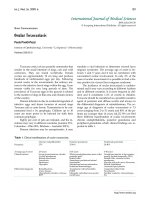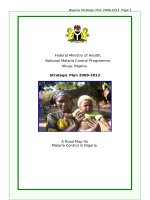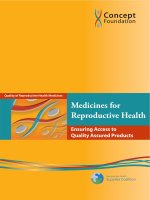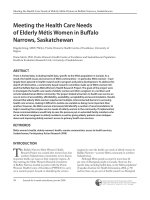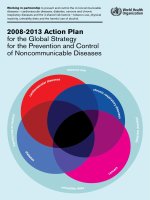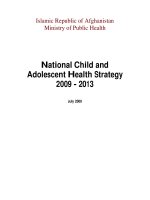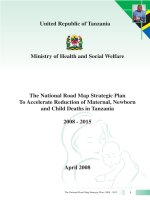Office of Health Administration August 2008: Mississippi State Department of Health Fiscal Years 2009 - 2013 Strategic Plan potx
Bạn đang xem bản rút gọn của tài liệu. Xem và tải ngay bản đầy đủ của tài liệu tại đây (498.79 KB, 170 trang )
Mississippi State Department of Health
Fiscal Years 2009 - 2013
Strategic Plan
Prepared in Accordance with the
Mississippi Performance Budget
and Strategic Planning Act of 1994
Office of Health Administration
August 2008
i
Table of Contents
MISSISSIPPI STATE DEPARTMENT OF HEALTH 1
CHRONIC ILLNESS 7
Home Health 9
Hypertension 12
Diabetes Treatment 14
MATERNAL AND CHILD HEALTH 17
Family Planning 19
Maternity/Perinatal Services 22
Child/Adolescent Health 26
Supplemental Food Program for Women, Infants, and Children (WIC) 29
Genetics (Newborn Screening) 33
First Steps: Early Intervention Program 36
Children's Medical Program 41
Oral Health Services 44
ENVIRONMENTAL HEALTH 49
Onsite Wastewater 51
Food Protection 54
Milk and Dairy Protection 58
General Environmental Services 61
Public Water Supply 65
Radiation Control 69
Boiler and Pressure Vessel Safety 74
DISEASE PREVENTION 77
Epidemiology 79
Immunization 83
HIV Disease Prevention and Control 87
Sexually Transmitted Disease 87
Tuberculosis (TB) 93
Public Health Statistics 97
Preventive Health 100
Breast and Cervical Cancer 108
Domestic and Sexual Violence Prevention and Education 112
HEALTH CARE PLANNING, SYSTEMS DEVELOPMENT, AND LICENSURE 117
Health Planning & Certificate of Need 119
Primary Care Development 122
ii
Rural Health Care Development 126
Emergency Medical Services (EMS) 130
Health Facilities Licensure and Certification 135
Professional Licensure 140
Child Care Facility Licensure 143
EMERGENCY PREPAREDNESS AND RESPONSE 147
Public Health Emergency Preparedness and Response 149
TOBACCO CONTROL 155
Tobacco Control 157
SUPPLEMENTAL PROGRAMS 161
Local Governments and Rural Water Systems Improvements 163
Mississippi Burn Care Fund 165
1
Mississippi State Department of Health
Mission Statement
The Mississippi State Department of Health mission is to promote and protect the health of the citizens of
Mississippi.
Vision Statement
The MSDH strives for excellence in government, cultural competence in carrying out its mission, and
local solutions to local problems.
Value Statement
The MSDH identifies its values as applied scientific knowledge, teamwork, and customer service.
Strategic Directions
The MSDH has identified the following areas to guide development of program objectives and strategies:
I. Strategic Planning and Policy Development
A. Strategic and operational planning
B. Community assessment
C. Information systems
D. Data analysis and quality review
E. Local and state health department performance and capacity assessment
F. Evaluation of services and policies based on 2010 health objectives
II. Healthy People in Healthy Communities
A. Epidemiological model utilization
B. Interventions based on causes of morbidity and mortality
C. Environmental health
D. Community health promotion
III. Quality Improvement and Performance Measurement
A. Human resource development
B. Cultural sensitivity and awareness
C. Team approach to fulfilling mission
D. Customer focus
E. Program and system performance monitoring
F. Linkages with academic centers
IV. Public Health Emergency Preparedness
A. Statewide planning
B. Partnership development for planning and implementation
C. Increased surveillance
D. Enhanced technology for training and communication
E. Enhanced system of early detection, reporting, and response
2
External Environmental Analysis
Numerous external factors may influence the agency's ability to reach its goals and objectives. MSDH is
strongly affected by changes in federal and state laws, regulations, and funding. In addition, the agency
must respond to changes in the health care system, an arena that remains particularly volatile. In Fiscal
Year 2007, Hurricane Katrina continued to have a major impact on the health care delivery system. The
following represent a summary of major external factors that the Department must consider in its
planning:
Demographic
• High poverty and unemployment rates, creating greater demands for public services
• Very rural population, creating transportation and service delivery problems
• Low education levels in the general population
• Poor local tax base; diminishing state dollars
• Increasing Spanish-speaking population
Health Status
• High mortality and morbidity rates
• High rates of behavioral risk factors
• High teen birth rates
Service Delivery System
• Increased attention to bioterrorism and other public health threats and emergencies
• Maldistribution of health care providers, especially physicians
• Shortages of nurses and other health care providers
• Lack of Community Health Centers statewide
• Uncertain third party and federal reimbursement levels
• Continuing excessive cost increases in the medical care arena: staff, equipment, and contractual items
• Changes in standard medical practice and malpractice insurance concerns
• Changes in program operations and practices mandated by state and federal legislation
Internal Management System
The MSDH has established a process to monitor program and service delivery activities carried out by
local health departments within the centralized organizational structure. The activities are composites of
all dimensions of the agency counties, districts, programs, disciplines, and related or support units. The
desired result is a continuous improvement in the quality of services delivered to the state’s citizens.
Internal Audit
Internal Audit staff conduct financial, compliance, electronic data processing, and operational and
efficiency audits of the Department of Health. Internal Audit staff also evaluate internal controls over
accounting systems, administrative systems, electronic data processing systems, and all other major
systems to ensure accountability.
3
Audits consist of all nine public health districts and each office unit in the Central Office. The Internal
Audit Director reviews all audits, and the director of each office or district receives a copy of the report
for response and corrective action. When appropriate, copies of supporting documentation, such as
memos or inventory forms, accompany the response. The reports, along with the response and corrective
action, are issued to the State Health Officer and the Board of Health each quarter in accordance with the
Mississippi Internal Audit Act.
Areas of major dispute, such as policy interpretation or disagreement, severe and immediate patient care
problems, or serious discrepancies in fiscal accountability, are handled individually by the State Health
Officer and the appropriate parties. Any item of a serious nature noted during the course of the audit and
requiring immediate action is brought to the State Health Officer’s attention at the time it is noted.
Related Reviews
The Quality Management Branch of the Division of Home Health conducts quality assurance reviews in
the home health regions, focusing on compliance with program guidelines and patient care. Copies of the
written reports from these reviews are handled in the same manner as the fiscal audits. Other offices in the
agency may also receive copies as appropriate based on the content of the review.
Other agency reviews include those coordinated by specific programs that have federal rules and
regulations requiring an ongoing compliance review process, and quality and performance reviews
conducted by county and district staff. These reviews are significant to the operations of selected
programs and activities and are an important part of the agency's total quality management program.
Generally, the aforementioned categories of related reviews are the responsibility of the specific program
manager and are not routinely routed to the State Health Officer unless problems arise. However, any
reports from these reviews may be considered in the program and service delivery review process as
indicated.
State audit and federal program review responses are also a significant part of the agency's operations.
Any responses to these reports are reviewed for consistency with other review responses, agency policies,
and follow-up requirements.
Complaint Investigation
Complaints from the public or from staff are relayed to Performance Accountability for follow-up.
Coordination with other offices, such as compliance or program offices, is planned as required by the
nature of the complaint. All complaints are investigated and reports are filed in writing for future
reference.
Program Plans
7
Chronic Illness
The mission of the Chronic Illness Program is to prevent unnecessary sickness and premature death due to
hypertension and diabetes and to offer comprehensive home care services to eligible patients who need these
services. The Home Health Program provides quality, cost-efficient, skilled care to home-bound persons
under the care of a physician and often provides care to those unserved by other entities. The Hypertension
and Diabetes Programs provide monitoring and treatment for a limited number of patients who have no
other means of obtaining it.
9
Home Health
Need: Home care is often a desirable, cost-effective, and acceptable alternative to institutional care and
is particularly needed with a rapidly increasing aged and medically disabled population, Medicare
prospective payments, Medicaid cost reductions, and spiraling health care costs. The increasing use of
early discharge is rapidly expanding the need for in-home services into younger segments of the
population, in addition to the elderly. As a result, the home health patient population is much sicker than
in past years, and requires specialized staff with knowledge of high tech procedures.
Program Description: The Home Health Program is designed to address the needs of persons who are
homebound and in need of medically supervised care. The program emphasizes effective, cost-efficient
service to eligible patients in their residence. Through a statewide network of regional offices, the MSDH
provides comprehensive care to patients who are under the care of a physician and who require the skills
of health professionals on an intermittent basis. Comprehensive services include skilled nursing and aide
visits, nutritional consultation, and psychosocial evaluation in all counties, with physical, speech, and
occupational therapy also provided in counties where personnel are available. Medical supplies may also
be provided as indicated by the patient's condition.
Program Goal: The goal of the Home Health Program is to provide quality, cost-efficient, skilled care
to meet the medical and therapeutic needs of home-bound persons in Mississippi.
FY 2008 Program Outputs
Number of patients served 753
Number of billed registered nurse visits 6,358
Number of non-billed nurse visits 479
Number of billed home health aide visits 40,117
Number of other billed visits (including physical, speech, and occupational therapy) 935
Number of non-billed evaluations by a social worker and/or nutritionist 50
FY 2008 Outcome Measures
Percentage of patients who stay at home after an episode of home health care ends:
MSDH Home Health
All Mississippi Home Health Agencies
56.8%
56.0%
Percentage of patients who are admitted to the hospital during a home health care
episode:
MSDH Home Health
All Mississippi Home Health Agencies
39.5%
40.0%
10
FY 2009 Objectives
:
• Increase the percentage of patients who stay at home after an episode of home health care ends by
1%.
• Decrease the percentage of patients who are admitted to the hospital during a home health episode by
.8%.
Funding: $ -0- General
-0- Federal
5,589,888
Other
$5,589,888 Total
FY 2010 Objectives
:
• Increase the percentage of patients who stay at home after an episode of home health care ends by
1%.
• Decrease the percentage of patients who are admitted to the hospital during a home health episode by
.8%.
Funding: $ -0- General
-0- Federal
6,157,644
Other
$6,157,644 Total
FY 2011 Objectives
:
• Increase the percentage of patients who stay at home after an episode of home health care ends by
1%.
• Decrease the percentage of patients who are admitted to the hospital during a home health episode by
1%.
Funding: $ -0- General
-0- Federal
5,732,098
Other
$5,732,098 Total
FY 2012 Objectives
:
• Increase the percentage of patients who stay at home after an episode of home health care ends by
1%.
• Decrease the percentage of patients who are admitted to the hospital during a home health episode by
1%.
Funding: $ -0- General
-0- Federal
5,732,098
Other
$5,732,098 Total
FY 2013 Objectives
:
• Increase the percentage of patients who stay at home after an episode of home health care ends by
1%.
11
• Decrease the percentage of patients who are admitted to the hospital during a home health episode by
1%.
Funding: $ -0- General
-0- Federal
5,732,098
Other
$5,732,098 Total
External Factors Affecting Program: Several other home health agencies provide services in some
areas of the state. In many cases, private agencies are able to advertise and provide referral source
incentives, which the MSDH does not. Therefore, the MSDH often finds it difficult to attract patients with
sufficient alternative payment sources in some areas of the state. However, the MSDH attempts to assure
services to those who need them, and provides care to those whom other entities do not wish to provide
services for or cannot accommodate, as well as being a first-choice provider for some patients.
12
Hypertension
Need: Hypertension is a major contributing factor to heart disease and kidney failure, and it is the single
most important risk factor for stroke. Mississippi is one of 11 states in the southeast region of the United
States known as the “Stroke Belt.” This region has for at least 50 years had higher stroke death rates than
other U.S. regions. Mississippi’s high prevalence of hypertension is likely an important reason for the high
coronary heart disease and stroke mortality rates in the state.
Program Description: The State Department of Health offers limited hypertension services through
county health departments. These services primarily consist of monitoring blood pressure for specific
patients referred by their private physician and providing hypertension medication to existing patients
who have no other means of obtaining it.
Program Goal: The goal of the Hypertension Program is to prevent premature death and undue illness
due to hypertension.
FY 2008 Program Outputs
Number of patients served 753
Number of hypertension treatment visits 1,350
Number of monitoring visits 343
FY 2009 Objectives
:
• Provide hypertension services according to MSDH protocol to at least 650 patients who are living at,
near, or below the poverty level.
Funding: $1,002,983 General
4,109,264 Federal
898,133
Other
$6,010,380 Total
FY 2010 Objectives
:
• Provide hypertension services according to MSDH protocol to at least 600 patients who are living at,
near, or below the poverty level.
Funding: $2,575,928 General
4,180,982 Federal
989,355
Other
$7,746,265 Total
FY 2011 Objectives
:
• Provide hypertension services according to MSDH protocol to at least 600 patients who are living at,
near, or below the poverty level.
13
Funding: $1,558,586 General
4,188,771 Federal
920,982
Other
$6,668,339 Total
FY 2012 Objectives
:
• Provide hypertension services according to MSDH protocol to at least 600 patients who are living at,
near, or below the poverty level.
Funding: $1,573,289 General
4,208,254 Federal
920,982
Other
$6,702,525 Total
FY 2013 Objectives
:
• Provide hypertension services according to MSDH protocol to at least 600 patients who are living at,
near, or below the poverty level.
Funding: $1,573,289 General
4,227,737 Federal
920,982
Other
$6,722,008 Total
14
Diabetes Treatment
Need: More than 200,000 Mississippians are estimated to have diabetes; approximately 2,200 suffer
significant diabetes-related complications each year. Diabetes is a significant risk factor for coronary
heart disease, stroke, and various complications of pregnancy.
Program Description: The Diabetes Treatment Program provides supportive services that include
joint medical management of diabetic patients with their private physicians. County health department
staff monitor patients referred by their physician and offer education, informational materials, and diet
counseling. Each patient receives annual counseling on the need for an annual eye exam, foot care, the
need to control hypertension, and the need to control the risk factors for diabetes. A limited number of
patients age 21 and under and those with gestational diabetes may obtain insulin, syringes, and testing
supplies. All pregnant diabetics are referred to the Perinatal High Risk Management Program.
Program Goal: The goal of the Diabetes Treatment Program is to prevent or postpone complications
and premature death due to diabetes.
FY 2008 Program Outputs
Number of patients served (provided insulin and syringes) 95
Number of diabetes treatment visits 38
Number of diabetes monitoring visits 107
FY 2009 Objectives
:
• Provide insulin and syringes according to MSDH protocol to at least 95 patients with diabetes.
Funding: $ -0- General
1,591,271 Federal
100,846
Other
$1,692,117 Total
FY 2010 Objectives
:
• Provide insulin and syringes according to MSDH protocol to at least 95 patients with diabetes.
Funding: $-0- General
1,619,044 Federal
111,088
Other
$1,730,132 Total
15
FY 2011 Objectives
:
• Provide insulin and syringes according to MSDH protocol to at least 95 patients with diabetes.
Funding: $-0- General
1,622,059 Federal
103,412
Other
$1,725,471 Total
FY 2012 Objectives
:
• Provide insulin and syringes according to MSDH protocol to at least 95 patients with diabetes.
Funding: $-0- General
1,629,604 Federal
103,412
Other
$1,733,016 Total
FY 2013 Objectives
:
• Provide insulin and syringes according to MSDH protocol to at least 95 patients with diabetes.
Funding: $ -0- General
1,637,148 Federal
103,412
Other
$1,740,560 Total
17
Maternal and Child Health
The mission of MSDH Maternal and Child Health programs is to reduce maternal and infant mortality,
morbidity, and low birth weight through prenatal and postnatal care; to reduce the incidence of unplanned
pregnancies; to provide assistance to children with special health care needs; to minimize the effects of
genetic disorders through early detection and timely medical evaluation, diagnosis, and treatment; and to
promote oral health among Mississippi’s children.
19
Family Planning
Need: Mississippi has one of the nation’s highest percentages of births to teens ─ in 2006, 16.5% of all
births in the state were to teenagers. Mississippi’s rate of births to teenagers age 15-19 was 68.4 per 1,000
births, compared to a national rate of 42 per 1,000 births. Teen mothers are more likely to drop out of
school, require long-term financial support, and be involved in child abuse. In addition, a majority of the
births among women with family incomes below the poverty level are unplanned. The Alan Guttmacher
Institute estimated 651,430 Mississippi women to be of reductive age (13-44) in 2006. More than half
(331,390) were in need of contraceptive services and supplies – they were sexually active and fertile, but
did not wish to become pregnant. Of this total, 197,050 women were in need of publicly funded
contraceptive services and supplies. The Guttmacher Institute estimated that 63 percent of this population
received the services needed to prevent pregnancy in 2006. The Institute further calculates that every
public dollar spent on family planning services to adults saves an average of $3.80 as a result of averting
short-term expenditures on medical services, welfare, and nutritional services.
Moreover, the Family Planning Program often serves as an entry point into the health care system for
people seeking care. The program provides access to yearly physicals, screening for cancer and sexually
transmitted diseases, and other services that many clients would not otherwise receive. Through
encouraging individuals to make choices regarding the spacing and number of their children and to
increase the interval between births, family planning plays an integral role in efforts to improve the health
of women and children in Mississippi. Prevention of unintended pregnancy has a significant positive
impact on the physical, emotional, financial, and social well-being of parents and their children.
Program Description: The MSDH Family Planning Program provides comprehensive reproductive
health care for low-income women, men, and adolescents. The program provides services through a
statewide network of more than 120 health care facilities including local health departments, community
health centers, and certain contracted agencies that provide contraceptives without other services. Family
Planning targets sexually active teenagers (age 19 and younger) at or below 100% of the federal poverty
level and women 20-44 years of age with incomes at or below 150% of the federal poverty level. A
multidisciplinary team provides services that include medical examinations involving pap smears and
pelvic exams, confidential counseling, nutrition education, social services, and contraceptive supplies.
Voluntary surgical sterilizations are available for men and women at risk who choose a permanent
method of contraception, and infertility services are available for persons desiring pregnancy.
Program Goal: The goal of the Family Planning Program is to improve maternal and infant health,
prevent unintended pregnancies, and reduce the incidence of teenage pregnancy.
FY 2008 Program Outputs
Number of unduplicated users 60,154
Number of users 19 years of age or younger 18,125
Number of male users 409
Number of family planning waiver clients served 17,721
20
FY 2008 Outcome Measures
Estimated total number of unplanned pregnancies prevented 9,805
Estimated number of unplanned pregnancies prevented to women 19 years of age
and younger
2,954
Percentage of adolescents served receiving enhanced counseling 100%
Percent of teen mothers pregnant with their second child
1
23%
Percent of births to girls less than 15 years of age
1
2.3%
Pregnancy rate among non-white girls aged 15-19 (per 100,000 population)
1
99.4%
1
Based on CY 2006 live birth data (most recent available)
FY 2009 Objectives
:
• Provide services to approximately 62,617 users through county health departments and
subcontractors, including 19,337 users aged 19 and younger.
• Increase the number of family planning waiver clients served by .5%.
• Increase the number of males receiving family planning services by 5% through special initiatives.
• Reduce the percent of teen mothers pregnant with their second child to 22.5%.
• Reduce the percent of births to girls less than 15 years of age to 2.2%.
• Reduce the pregnancy rate among non-white girls age 15-19 to 96.4 per 100,000 population.
Funding: $ 2,017,675 General
7,938,202 Federal
13,939,629
Other
$23,895,506 Total
FY 2010 Objectives
:
• Provide services to approximately 68,878 users through county health departments and
subcontractors, including 20,240 users aged 19 and younger.
• Increase the number of family planning waiver clients served by .5%.
• Increase the number of males receiving family planning services by 5% through special initiatives.
• Reduce the percent of teen mothers pregnant with their second child to 22%.
• Reduce the percent of births to girls less than 15 years of age to 2.1%.
• Reduce the pregnancy rate among non-white girls age 15-19 to 93.4 per 100,000 population.
Funding: $ 2,819,054 General
8,030,592 Federal
14,170,820
Other
$25,020,466 Total
21
FY 2011 Objectives
:
• Provide services to approximately 68,900 users through county health departments and
subcontractors, including 20,240 users aged 19 and younger.
• Increase the number of family planning waiver clients served by .5%.
• Increase the number of males receiving family planning services by 2%.
• Reduce the percent of teen mothers pregnant with their second child.
• Reduce the percent of births to girls less than 15 years of age.
• Reduce the pregnancy rate among non-white girls age 15-19.
Funding: $ 3,135,367 General
8,091,792 Federal
14,294,261
Other
$25,521,420 Total
FY 2012 Objectives
:
• Provide services to approximately 68,900 users through county health departments and
subcontractors, including 20,240 users aged 19 and younger.
• Increase the number of family planning waiver clients served by .5%.
• Increase the number of males receiving family planning services by 2%.
• Reduce the percent of teen mothers pregnant with their second child.
• Reduce the percent of births to girls less than 15 years of age.
• Reduce the pregnancy rate among non-white girls age 15-19.
Funding: $ 3,164,946 General
8,129,429 Federal
14,294,261
Other
$25,588,636 Total
FY 2013 Objectives
:
• Provide services to approximately 68,900 users through county health departments and
subcontractors, including 20,240 users aged 19 and younger.
• Increase the number of family planning waiver clients served by .5%.
• Increase the number of males receiving family planning services by 2%.
• Reduce the percent of teen mothers pregnant with their second child.
• Reduce the percent of births to girls less than 15 years of age.
• Reduce the pregnancy rate among non-white girls age 15-19.
Funding: $ 3,164,946 General
8,167,066 Federal
14,294,262
Other
$25,626,274 Total
